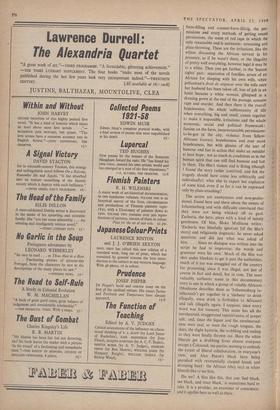Cinema
Beyond the Pale
By ISABEL QUIGLY Come Back Africa.
(International Film Theatre, Westbourne Grove.) 'By the time he was ready to shoot his film,' Bloke Modisane writes' about Lionel Rogosin, who went to South Africa to film what apartheid feels like when you live on the wrong side of it, 'he could feel black, see black, and react black.' So blackly, in fact, that it is almost inevitable a white person should end by feeling--what with the insipid, pinched. acidulous-looking whites we are shown, and the vitality and expressiveness of the untrained coloured actors--pale in every sense, emotionally under par, undercoloured rather than suitably coloured, like half-baked bread or an unlit plant. Which is Come Back Africa's limitation, very understandable and perhaps inevitable when you consider the emotional language of sight, but a limitation just the same, since whites can't help their colour any more than anyone Ose can, and racialism cuts both ways. However, there it is, and as I have said a dreary number of times in the case of war films it's almost impossible, with a medium that makes its points visually, to show you hate what a particular race does without looking as if you hate what the race itself looks like.
At the lightest level, Conte Back Africa ('A' certificate) shows apartheid as a policy of endless irritation, of pinpricks every minute of the day; so much so that when the hero starts hurling plates at the wall one can (quite apart from the tragedy that has just hit him) sympathise with it as the only possible solution. Officialdom run mad among often illiterate people: few things could be more tragically absurd than all the
form-filling and counter-form-filling, the per- missions and crazy methods of getting round permissions, the maze of red tape in which the only reasonable end is unreason: screaming and plate-throwing. These are the irritations, like the whites discussing the African servant in his presence, as if he wasn't there, or the illegality of pretty well everything, however legal it may be to a white. Then you get further, to the 'human rights' part : separation of families, arrest of an African for sleeping with his own wife, white policeman's droit de seigneur over the wife once her husband has been taken off, loss of job in an hotel because a white woman, glimpsed in a dressing gown at the end of the passage, screams rape and murder. And then there is the overall hopelessness, the whole subhumanity of life when everything, big and small, comes together to make it impossible, irritations and the whole economic, social and political framework: famine on the farm, insurmountable permissions- to-be-got in the city, violence from fellow- Africans (tsotsis), hopelessness and ever more hopelessness, but with gleams of the sort of humour and fun in action that make an outsider a: least hope: not so much in conditions as in the human spirit that can still find humour and fun in them. The film's violent end is fitting (though I found the story rather contrived, and felt the tragedy should have come less arbitrarily and individually); what else to expect but explosion of some kind, even if so far it can be expressed only by plate-smashing?
The actors are anonymous and non-profes- sional, found here and there about the streets of Johannesburg and with difficulty convinced that they were not being whisked off to gaol. Zacharia, the hero, plays with a kind of saintly gentleness. Of him, Bloke Modisane writes: `Zacharia was blissfully ignorant [of the film's story] and religiously dogmatic; he never asked questions and did just what was asked of him. . . . Since no dialogue was written into the script he had to improvise; the words and grammar were his own.' Much of the film was shot under blankets to get it past the authorities, much of it too was smuggled out of the country for processing, since it was illegal, not just of course in fact and detail, but in tone. The most valuably authentic scene in this documentary story is one in which a group of voluble Africans (Modisane describes them as `Johannesburg in- tellectuals') get together in a `shebeen' to drink (illegally, since drink is forbidden to Africans) and talk (illegally again, I suppose, since every word was hot treason). This scene has all the unrehearsed, exaggerated repetitiveness of proper talk; and, since the liquor and the unrehearsed- ness were real, so were the rough tongues, the slurs, the slight hysteria, the wobbling and reeling as they were finally thrown out. Here the white liberals get a drubbing from almost everyone except a Coloured; tea-parties seeming to embody the extent of liberal collaboration, in everyone's view, and Alan Paton's black hero being parodied with reverentially clasped hands and drooping head : the African (they say) as white liberals like to see him.
Do we? A film like this, that can 'feel black, see black, and react black,' is sometimes hard to take. It is a prodder, an examiner of conscience; and it applies here as well as there.











































 Previous page
Previous page